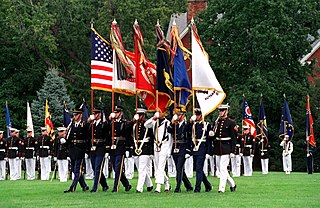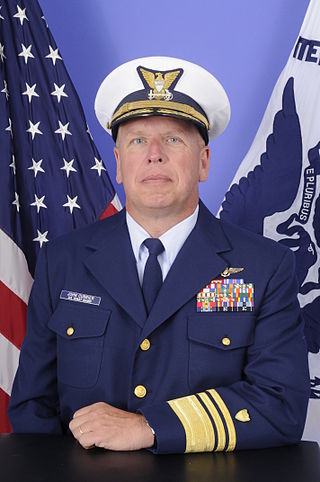Commodore is a senior naval rank used in many navies which is equivalent to brigadier or brigadier general and air commodore. It is superior to a navy captain, but below a rear admiral. It is either regarded as the most junior of the flag officers rank or may not hold the jurisdiction of a flag officer at all depending on the officer's appointment. Non-English-speaking nations commonly use the rank of flotilla admiral, counter admiral, or senior captain as an equivalent, although counter admiral may also correspond to rear admiral lower half abbreviated as RDML.

The United States Coast Guard (USCG) is the maritime security, search and rescue, and law enforcement service branch of the United States Armed Forces and one of the country's eight uniformed services. The service is a maritime, military, multi-mission service unique among the United States military branches for having a maritime law enforcement mission with jurisdiction in both domestic and international waters and a federal regulatory agency mission as part of its duties. It is the largest coast guard in the world, rivaling the capabilities and size of most navies.

The Women's Royal Naval Service was the women's branch of the United Kingdom's Royal Navy. First formed in 1917 for the First World War, it was disbanded in 1919, then revived in 1939 at the beginning of the Second World War, remaining active until integrated into the Royal Navy in 1993. WRNS included cooks, clerks, wireless telegraphists, radar plotters, weapons analysts, range assessors, electricians and air mechanics.

The several branches of the United States Armed Forces are represented by flags. Within the U.S. military, various flags fly on various occasions, and on various ships, bases, camps, and military academies.
Air commodore is a air officer rank used by some air forces, with origins from the Royal Air Force. The rank is also used by the air forces of many countries which have historical British influence and it is sometimes used as the English translation of an equivalent rank in countries which have a non-English air force-specific rank structure.

The United States Coast Guard Auxiliary is the uniformed, non-military volunteer component of the United States Coast Guard. Congress established the unit on 23 June 1939, as the United States Coast Guard Reserve. On February 19, 1941, the entity was renamed the United States Coast Guard Auxiliary. The Auxiliary's purpose is to bolster all USCG undertakings both at sea and in the sky, with the exception of tasks necessitating "direct" law enforcement or military actions. As of 2022, the U.S. Coast Guard Auxiliary boasted around 21,000 members.
An air officer is an air force officer of the rank of air commodore or higher. Such officers may be termed "officers of air rank". While the term originated in the Royal Air Force, air officers are also to be found in many Commonwealth nations who have a similar rank structure to the RAF.
Naco, NACO, or NACo may refer to:

The United States Coast Guard Reserve is the reserve component of the United States Coast Guard. It is organized, trained, administered, and supplied under the direction of the Commandant of the Coast Guard through the Assistant Commandant for Reserve (CG-R).

The commandant of the Coast Guard is the service chief and highest-ranking member of the United States Coast Guard. The commandant is an admiral, appointed for a four-year term by the president of the United States upon confirmation by the United States Senate. The commandant is assisted by a vice commandant, who is also an admiral, and two area commanders and two deputy commandants, all of whom are vice admirals.

The Philippine Coast Guard (PCG) is the third armed uniformed service of the country attached to the Philippines' Department of Transportation, tasked primarily with enforcing laws within Philippine waters, conducting maritime security operations, safeguarding life and property at sea, and protecting marine environment and resources; similar to coast guard units around the world. In case of a declaration of war, the Coast Guard shall also serve as an attached service of the Department of National Defense.
Admiral is a four-star commissioned officer rank in the United States Navy, the United States Coast Guard, and the United States Public Health Service Commissioned Corps with the pay grade of O-10. Admiral ranks above vice admiral and below fleet admiral in the Navy; the Coast Guard and the Public Health Service do not have an established grade above admiral. Admiral is equivalent to the rank of general in the other uniformed services. The National Oceanic and Atmospheric Administration Commissioned Officer Corps has never had an officer hold the grade of admiral. However, 37 U.S.C. § 201 of the U.S. Code established the grade for the NOAA Corps, in case a position is created that merits the four-star grade.

Vice Admiral John P. Currier was the 28th Vice Commandant of the United States Coast Guard. He assumed the position from Vice Admiral Sally Brice-O'Hara on May 18, 2012 and was relieved on May 20, 2014 by Vice Admiral Peter Neffenger.
Commodore was an early title and later a rank in the United States Navy, United States Coast Guard and the Confederate States Navy, and also has been a rank in the United States Public Health Service Commissioned Corps and the National Oceanic and Atmospheric Administration Commissioned Officer Corps and its ancestor organizations. For over two centuries, the designation has been given varying levels of authority and formality.
This article covers the organization of the United States Coast Guard.
United States Coast Guard officer rank insignia describes an officer's pay-grade. Rank is displayed on collar devices, shoulder boards, and on the sleeves of dress uniforms.

A rear admiral in the uniformed services of the United States is either of two different ranks of commissioned officers: one-star flag officers and two-star flag officers. By contrast, in most other countries, the term "rear admiral" refers only to an officer of two-star rank.

Charles Ward "Tommy" Thomas was a flag officer in the United States Coast Guard and commanding officer of the icebreakers USCGC Northland (WPG-49) and USCGC Eastwind (WAGB-279) that served in the Greenland Patrol during World War II. In August 1945 he was appointed commander of Greenland Patrol. After the war he was commanding officer of USCGC Northwind (WAGB-282) during Operation Highjump; The United States Navy Antarctic Developments Project 1946–1947, also known as the Fourth Byrd Antarctic Expedition. Later followed expeditions in the Bering Sea.

In the United States Navy, United States Coast Guard, United States Public Health Service Commissioned Corps, and National Oceanic and Atmospheric Administration Commissioned Officer Corps, captain is the senior-most commissioned officer rank below that of flag officer. The equivalent rank is colonel in the United States Army, Air Force, Space Force, and Marine Corps.



















